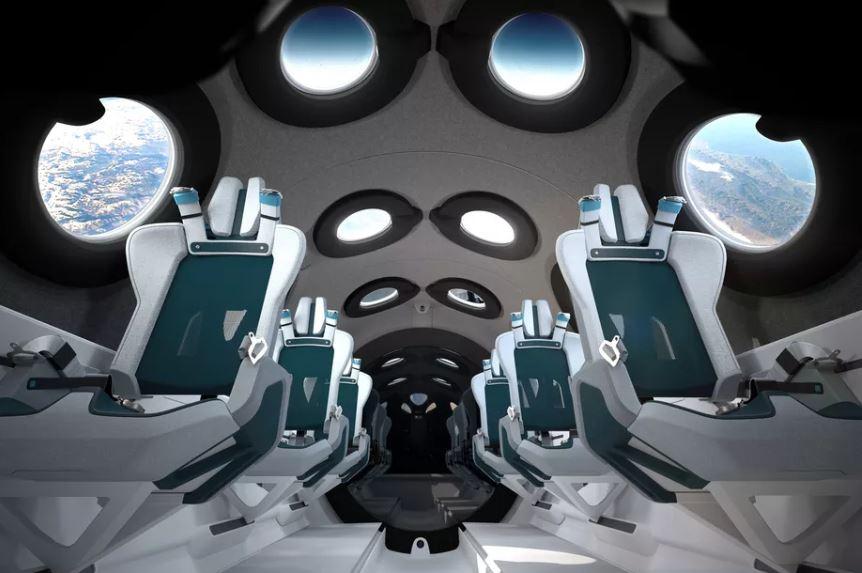
With commercial flights aboard the suborbital SpaceShipTwo vehicle approaching, Virgin Galactic on July 28 unveiled the ship’s cabin.
The sleek, mimimalistic design is intended to blend safety for six passengers with maximizing the novel view of Earth from the edge of space and the ability to experience a few minutes of weightlessness unstrapped from seats.
The six seats are attached to the vehicle’s sidewalls, leaving the floor space open. They are set up in three rows, with one seat along each side of the cabin, which is 7.5 ft. (2.3 m) in diameter. The passenger section is set slightly below the cockpit, which will be occupied by two Virgin Galactic pilots.
The seats, made of aluminum and carbon fiber, have variable-height backs that can be configured to accommodate a wide variety of body shapes and sizes, from petite, 100-lb. grandmothers to beefy, 300-lb. football players, Virgin Galactic’s Chief Space Officer George Whitesides told Aerospace DAILY ahead of the cabin unveiling, held virtually on YouTube due to the novel coronavirus pandemic.
Whitesides, previously the company’s CEO, turned over that role on July 20 to former Disney executive Michael Colglazier, who is charged with building the Virgin Galactic spaceflight experience into a multibillion-dollar commercial operation.
“You have to build from safety to comfort to experience,” Whitesides said. “The seat, for example, has to sustain a certain amount of G’s, with a certain amount of loads, and you connect that load into [the] cabin wall and do all that in a safe way.
“They have a really elegant design,” he continued. “It doesn’t translate straight down, it translates sideways into the sidewall, which is a clever way to keep the cabin relatively free and flexible because once you go into space there is no ‘floor’ anymore. You’ll have this entire volume to play in. We tried to create a basic structural system that minimized the amount of volume that the seats had to maintain in the cabin and the best way to do that was to attach the seats to the cabin wall itself.”
The incline of seats will be automatically adjusted by the pilots to maximize safety and enhance the experience during the various phases of flight, from boost, to coast up to apogee more than 50 mi. above the planet’s surface, and then atmospheric reentry and landing.
“Between safety and comfort are a whole bunch of other design metrics, such as how the seat wraps around you a little bit, from your head to your shoulders and down to your torso,” Whitesides said. “We’re going to tailor the seats because in general with transportation seating you have one-size-fits-all and that is not optimal when you really look at the variability of the human form. To actually accommodate those shapes, volumes and weights is tricky to do in a way that makes them all comfortable.”
To enhance the experience of flying beyond the atmosphere, Virgin Galactic chose a neutral palette for the interior so as not to detract from the views of Earth. “I think it’s a graceful and elegant selection of material colors. We didn’t want bright hues all over the place that distract from your experience of looking out,” Whitesides said.
Each seat is positioned next to side and overhead windows that are wrapped in soft handgrips to help passengers navigate during the microgravity part of the flight.
Passengers will be able to unclip their five-point harness with a single release mechanism to experience weightlessness, if they so choose. The seat backs, likewise, are dressed in materials, designed by spacesuit manufacturer Under Armour, to serve as handholds to help passengers move around the cabin.
The interior also includes a palette of lighting options, which will be autonomously controlled throughout the phases of flight, including a dark cabin to enhance the views of Earth and space. At the rear of the cabin is a large, round mirror for self-viewing during the weightless portion of flight. In addition, 16 cameras will be rolling to provide passengers with photos and video footage.
Virgin Galactic is preparing for its first powered flight since the spaceship, known as VSS Unity, has been relocated from its manufacturing and primary test facilities at the Mojave Air and Space Port in California to its operational base near Las Cruces, New Mexico.
If the powered flight test goes as planned, the company intends to conduct a short series of flights with four Virgin Galactic employees flying in the passenger cabin for additional assessments prior to the start of commercial service.
“We’ll let the engineers dictate the schedule, but we’re getting pretty close now,” Whitesides said.





